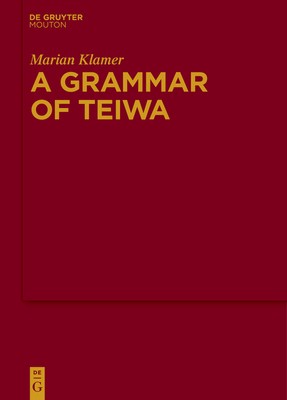
- We will send in 10–14 business days.
- Author: Marian Klamer
- Publisher: Walter de Gruyter
- Year: 2010
- Pages: 558
- ISBN-10: 3110226065
- ISBN-13: 9783110226065
- Format: 17 x 24.4 x 3 cm, hardcover
- Language: English
- SAVE -10% with code: EXTRA
Reviews
Description
Teiwa is a non-Austronesian ('Papuan') language spoken on the island of Pantar, in eastern Indonesia, located just north of Timor island. It has approx. 4,000 speakers and is highly endangered. While the non-Austronesian languages of the Alor-Pantar archipelago are clearly related to each other, as indicated by the many apparent cognates and the very similar pronominal paradigms found across the group, their genetic relationship to other Papuan languages remains controversial. Located some 1,000 km from their putative Papuan neighbors on the New Guinea mainland, the Alor-Pantar languages are the most distant westerly Papuan outliers. A grammar of Teiwa presents a grammatical description of one of these 'outlier' languages.
The book is structured as a reference grammar: after a general introduction on the language, it speakers and the linguistic situation on Alor and Pantar, the grammar builds up from a description of the language's phonology and word classes to its larger grammatical constituents and their mutual relations: nominal phrases, serial verb constructions, clauses, clause combinations, and information structure. While many Papuan languages are morphologically complex, Teiwa is almost analytic: it has only one paradigm of object marking prefixes, and one verbal suffix marking realis status. Other typologically interesting features of the language include: (i) the presence of uvular fricatives and stops, which is atypical for languages of eastern Indonesia; (ii) the absence of trivalent verbs: transitive verbs select a single (animate or inanimate) object, while the additional participant is expressed with a separate predicate; and (iii) the absence of morpho-syntactically encoded embedded clauses. A grammar of Teiwa is based on primary field data, collected by the author in 2003-2007. A selection of glossed and translated Teiwa texts of various genres and word lists (Teiwa-English / English-Teiwa) are included.
EXTRA 10 % discount with code: EXTRA
The promotion ends in 17d.15:27:21
The discount code is valid when purchasing from 10 €. Discounts do not stack.
- Author: Marian Klamer
- Publisher: Walter de Gruyter
- Year: 2010
- Pages: 558
- ISBN-10: 3110226065
- ISBN-13: 9783110226065
- Format: 17 x 24.4 x 3 cm, hardcover
- Language: English English
Teiwa is a non-Austronesian ('Papuan') language spoken on the island of Pantar, in eastern Indonesia, located just north of Timor island. It has approx. 4,000 speakers and is highly endangered. While the non-Austronesian languages of the Alor-Pantar archipelago are clearly related to each other, as indicated by the many apparent cognates and the very similar pronominal paradigms found across the group, their genetic relationship to other Papuan languages remains controversial. Located some 1,000 km from their putative Papuan neighbors on the New Guinea mainland, the Alor-Pantar languages are the most distant westerly Papuan outliers. A grammar of Teiwa presents a grammatical description of one of these 'outlier' languages.
The book is structured as a reference grammar: after a general introduction on the language, it speakers and the linguistic situation on Alor and Pantar, the grammar builds up from a description of the language's phonology and word classes to its larger grammatical constituents and their mutual relations: nominal phrases, serial verb constructions, clauses, clause combinations, and information structure. While many Papuan languages are morphologically complex, Teiwa is almost analytic: it has only one paradigm of object marking prefixes, and one verbal suffix marking realis status. Other typologically interesting features of the language include: (i) the presence of uvular fricatives and stops, which is atypical for languages of eastern Indonesia; (ii) the absence of trivalent verbs: transitive verbs select a single (animate or inanimate) object, while the additional participant is expressed with a separate predicate; and (iii) the absence of morpho-syntactically encoded embedded clauses. A grammar of Teiwa is based on primary field data, collected by the author in 2003-2007. A selection of glossed and translated Teiwa texts of various genres and word lists (Teiwa-English / English-Teiwa) are included.


Reviews